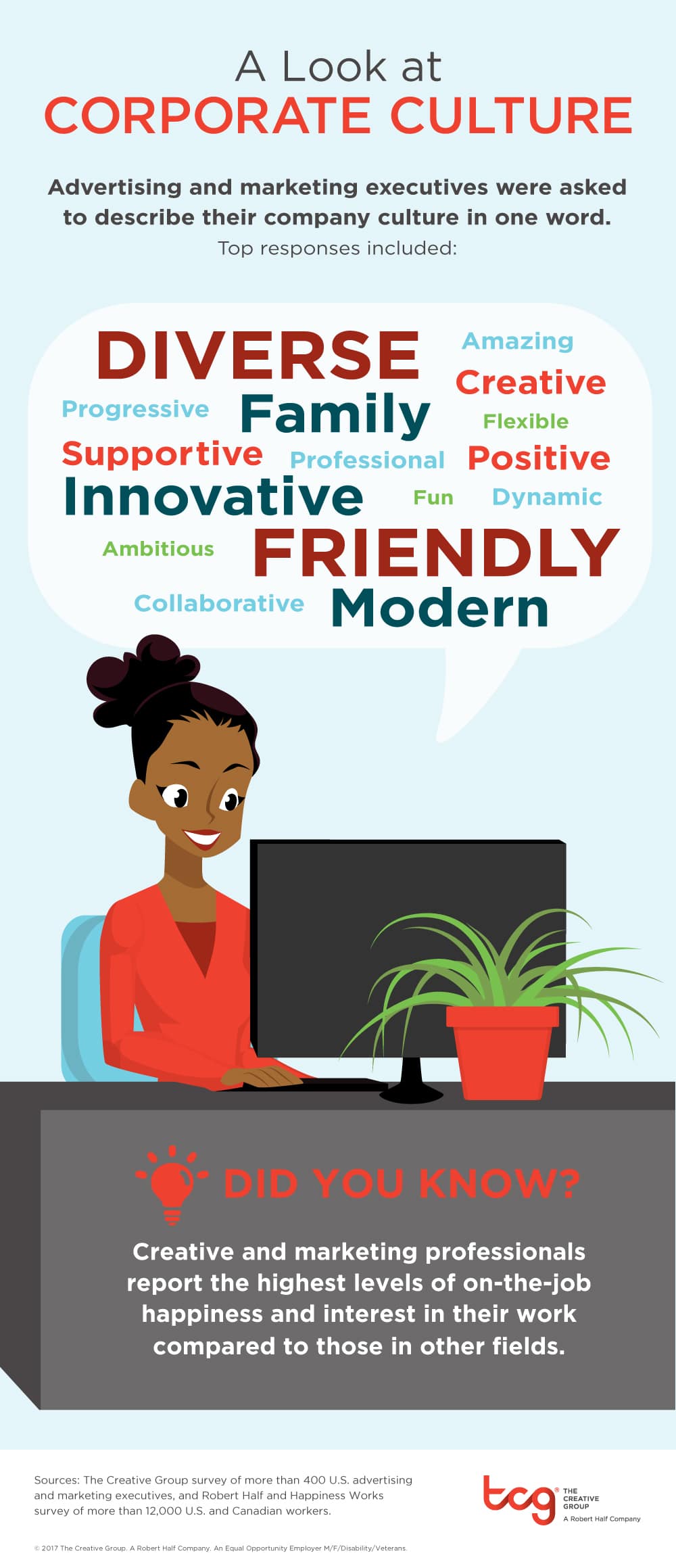When it comes to career happiness, creative professionals are coming out ahead, recent research shows. According to a study of more than 12,000 U.S. and Canadian workers by global staffing firm Robert Half and Happiness Works, those in the creative and marketing occupations reported the highest levels of on-the-job satisfaction and interest in their work, compared to employees in the accounting and finance, administrative, legal, and technology fields.
In a separate survey, The Creative Group, a division of Robert Half, asked more than 400 U.S. advertising and marketing executives to describe their company culture in one word. Many creative managers also seem satisfied with their work environment, as top responses trended positive:
- Friendly
- Diverse
- Family
- Innovative
- Modern
- Creative
- Supportive
- Collaborative
- Dynamic
- Progressive

The survey of advertising and marketing executives revealed some distinctions between how those who work in agencies and corporations describe their environments. Following are some responses unique to each group:
Advertising executives
- Entrepreneurial
- Futuristic
- Hardworking
- Intense
- Nimble
- Playful
- Risky
- Vocal
Marketing executives
- Adaptable
- Accountable
- Caring
- Dependable
- Enthusiastic
- Fluid
- Inclusive
- Intrepid
Only a handful of executives had a negative impression of their company culture, describing it as:
- Aggressive
- Complacent
- Hectic
- Reserved
- Struggling
“Company culture is a key contributor to employee happiness and a top consideration for job seekers,” said Diane Domeyer, executive director of The Creative Group, in a news release. “To attract and retain top talent, companies need to take a close look at what makes their corporate culture unique and enjoyable, and then promote it to potential employees.”
The Creative Group offers five tips for managers to foster an attractive, authentic company culture:
Add meaning to the job
The top driver of career satisfaction for creative professionals is doing worthwhile work, according to the Robert Half and Happiness Works study. Your team will be more engaged and enthusiastic if you assign them a variety of projects and make sure they understand how their contributions support your organization’s overall purpose.
Create a learning environment
Show employees you are invested in their long-term career growth. Let staff attend trainings during business hours or send them to industry conferences, and ask individuals to share what they learn with their colleagues.
Be flexible
Many professionals want the freedom to work when and where they want. Consider offering telecommuting or alternative scheduling options if you don’t already provide them.
Customize the workspace
Your physical environment can have a big impact on employees’ moods and productivity. Construct spaces to accommodate different needs, like open areas for collaboration and private stations where staff members can concentrate free of distractions.
Keep it real
Fun perks like free snacks are great, but they cannot compensate for significant issues—like a culture of mistrust or lack of transparency. Potential hires will know if you’re trying to woo them with cool perquisites to cover up problems.
The survey of more than 12,000 workers in the United States and Canada was developed by Robert Half and Happiness Works and conducted by an independent research firm. The survey of more than 400 U.S. advertising and marketing executives was developed by The Creative Group and conducted by an independent research firm.



